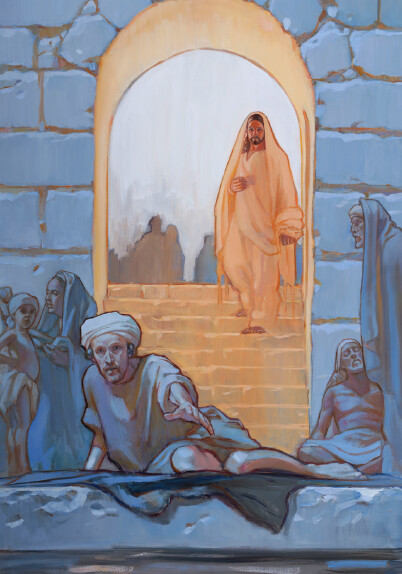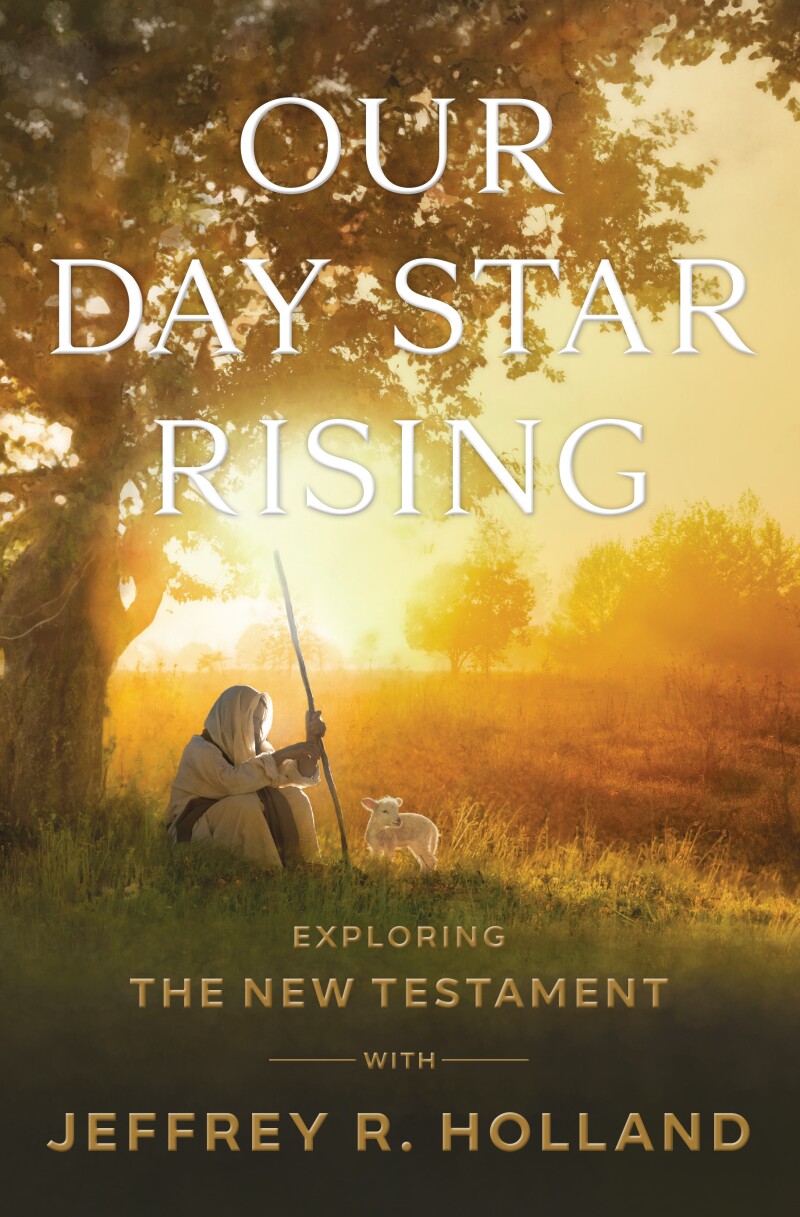Throughout the New Testament, Christ invited all to be lifted heavenward—in vision, heart, and hope. In his new book Our Day Star Rising, Elder Holland provides two striking examples from the book of John that show how Christ extends His hand to every one of us.
“Lift Up Your Eyes” (John 4)

While traveling through Samaria among people intensely despised by the Jews of that day, Jesus and His disciples passed by the city of Sychar, “near to the parcel of ground that Jacob gave to his son Joseph” (John 4:5). This area, which included within its borders Jacob’s well, was uniquely symbolic of the Jewish-Samaritan animosity. Samaritans spoke strongly for their ancestral tie to Jacob—and the Jews denied them that assertion with equal vehemence. Did Jesus choose just such a location to lift the sight of both groups, too long limited by dark traditions?
While His disciples went into the city to buy food (it was the noon hour), Jesus sat on the stone perimeter of the well and watched a Samaritan woman approach with her waterpot in hand. The woman must have been very surprised to hear this Jewish traveler speak to her as she was preparing to lower her waterpot for water. Not only was a man speaking to a woman He did not know, but more strikingly, He was a Jew addressing a Samaritan. Nevertheless, He said to her, “Give me to drink.”
She questioned His request, as well she might, and Jesus had exactly the teaching situation He wanted.
“If thou knewest the gift of God,” He said, “and who it is that saith to thee, Give me to drink; thou wouldest have asked of him, and he would have given thee living water.”
Here the Savior instantly introduced a hint of His true identity, a revelation that could indeed be “living water” to this woman if she could grasp heavenly things. But she showed no such inclination, wondering aloud how this man could possibly give her any water—living or otherwise—when He had nothing to draw with from such a deep well.
Jesus went on. Referring to temporal sustenance, He said, “Whosoever drinketh of this water shall thirst again.” Then He said, “But whosoever drinketh of the water that I shall give him shall never thirst; but the water that I shall give him shall be in him a well of water springing up into everlasting life.”
This profound declaration so movingly spoken clearly captured the Samaritan woman’s attention. But she was still caught up in the common—rather than the uncommon—possibilities. She could not see His higher purpose, but she was certainly interested in a perpetual source of water that would spare her these difficult daily trips to the well! “Sir,” she said respectfully, “give me this water, that I thirst not, neither come hither to draw.”
Jesus reached out one more time to help her understand. He tried to help by speaking of her most personal earthly things and asked her to call her husband. She replied that she had no husband. Jesus said, in effect, you certainly do not, and I include in that denial not only the man with whom you are now living but perhaps also the five who preceded him. At this stunning revelation the woman cried out, “Sir, I perceive that thou art a prophet.”
Surely it is fair to assume that Christ would have preferred to talk to the woman about living water rather than bogus husbands. But He met the student where she was in order to take her where she needed to go. Indeed, He took the most common of women in one of the most common, yet serious, sins and lifted her to uncommon opportunity. In response to her confession that “I know that Messias cometh, which is called Christ,” He replied powerfully and pointedly: “I that speak unto thee am he” (John 4:25–26).
Jesus seized on earthly things the woman could understand in order to lift her toward heavenly things she did not understand.
But what of others closer to Christ and stronger of spirit? We might suppose that an unfaithful woman of Samaria might have considerable difficulty breaking away from the commonplace that held her down. But what of Jesus’s disciples? An answer to that question, at least in part, follows immediately in John’s narrative.
Just as Jesus was concluding His discussion with the Samaritan woman, His disciples returned from the village with food for a midday meal, “saying, Master, eat.
“But he said unto them, I have meat to eat that ye know not of” (John 4:31–32).
Obviously, Jesus was referring to the “sustenance” of the experience He had just had with the Samaritan woman. He had, in a very few moments, lifted her from probable hostility and spiritual stupor to a state where she at least began to glimpse spiritual matters and heard in a wonderfully rare moment the Son of God declare Himself to be the long-awaited Messiah. This was “meat” to One who fed on things of the Spirit—more so than a common crust of bread or literal cut of lamb so faithfully obtained in town by His brethren.
But very much like the Samaritan woman before them, the disciples had not yet had enough experience to understand.
“Hath any man brought him ought to eat?” they asked in bewilderment. If He has had meat to eat we know not of, who brought it to Him and why did He send us into the city? they wondered. Why would He have us make such an effort and then eat here with another before we returned?
We smile slightly at this moment of confusion because we know what has transpired in their absence. Perhaps if they had known why Jesus was speaking to the woman and what it was He had said, they would have more readily understood His reference to eating meat of quite a different kind. Christ’s “meat,” like His “living water,” would leave one filled for eternity. In His gentle, patient, uncommon way, Christ lifted His beloved followers from the commonplace.
“My meat is to do the will of him that sent me, and to finish his work.
“Say not ye, there are yet four months, and then cometh harvest? Behold, I say unto you, Lift up your eyes, and look on the fields; for they are white already to harvest.”
Jesus had seen an opportunity with eternal significance and seized it. For Him, the field was always ready to harvest. He saw past the traditions and the wrangling and the pettiness of men. Indeed, He had even seen past the woman’s very serious sins. What He saw was a chance to lift a life, to teach a human soul, to edify a child of God, and move her toward salvation. That was His “meat” and His “work.” Certainly, it was the will of His Father, which He had come to fulfill. Even these disciples who had become so close to the Master had yet to shed fully the scales of traditional darkness from their view. They too needed the uncommon invitation commonly extended to lift up their eyes to higher purposes, loftier meanings, more spiritual sustenance (see John 4:27–35).
After noting a few such incidents, it becomes clear that this same lesson is taught by the Savior again and again. Jesus spoke of temples and the people thought He spoke of temples (see John 2:18–21). He spoke of bread and the people thought he spoke of bread (see John 6:30–58). And so on. And these were not merely parables in the allegorical sense of multiple applications of a single saying. They were in every case an invitation to “lift up your eyes,” to see heavenly things—specifically to see and understand Him. But they are also repeated manifestations of His willingness to meet people on their own terms, however limited that understanding, and there lead them on to higher ground. Ultimately, if they would, it would lead them beyond time and space altogether, into eternity.
“Rise, … and Walk” (John 5)
One marvelous incident of the Savior’s healing is recorded in the fifth chapter of John. It occurred at the time of the feast of the Jews, probably the Passover, and Jesus had come up to Jerusalem to celebrate this sacred occasion. It was the Sabbath, and Jesus, probably on His way to the temple, passed by a pool called Bethesda, or literally “the House of Mercy.”

Surrounding the pool was a great multitude of the blind, halt, and withered, all waiting for a chance to step into this legendary pool. The tradition of the time was that when the waters of Bethesda were troubled, it was the work of an angel; therefore the first to enter the water following that divine manifestation would be healed. John’s account refers to one man, lame for thirty-eight years, who had not the physical strength to match His faith. Day in and day out He came to the pool to be healed, but day in and day out He was not mobile enough to be able to enter the water first. On this day mentioned, Jesus noticed the man and “knew that he had been a long time in that case.” Jesus stopped, looked at him, and said, “Wilt thou be made whole?” The lame man, considering the thirty-eight years of his condition, may well have thought that either a naïve or cruel question. But surely the loving look in the eye of the Stranger not only merited his respect but gave him hope. With honesty, he kept looking into those eyes and said, “Sir, I have no man … to put me in the pool.” Said Jesus, “Rise, take up thy bed, and walk.” In that instant, the lame man was made whole (John 5:1–11).
My friends, that same loving hand reaches out to us. That same compassionate voice assuredly invites us, “Come unto me, all ye that labour and are heavy laden, and I will give you rest. Take my yoke upon you, and learn of me; for I am meek and lowly in heart: and ye shall find rest unto thy souls. For my yoke is easy and my burden is light” (Matthew 11:28–30). Over and over again we read that the Lord’s hand is stretched out still (see, for example, Isaiah 5:25; 9:12, 17). “And how merciful is our God unto us, … and he stretches forth his hands … all the day long” (Jacob 6:4).
Our Day Star Rising
Among the many names of Christ is the Day Star—the sun—that "shineth in a dark place until the day dawn...in your hearts" (2 Peter 1:19). Our lives will have difficult periods, which may go on for days, months, or even years. But in all of it, somehow, not only when He comes again but also during the anticipation of His coming, we can rest assured that His light will guide us unfailingly through. This book reminds us of the promise that, if we wait for it and watch for it and want it badly enough, our Day Star will most certainly arise in our hearts.

